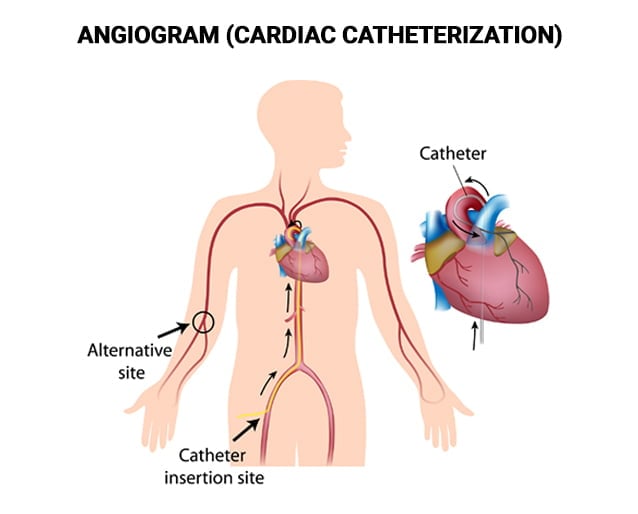If you are at high risk of heart disease or your symptoms indicate a heart issue, your doctor may recommend an angiogram or cardiac catheterization, an imaging procedure to detect heart diseases. Using the latest diagnostic equipment, the heart doctor will check how well your blood vessels are supplying blood to the heart and if there is any blockage that needs immediate attention. The top-rated cardiologists at the Century Medical and Dental Center diagnose and treat a wide range of cardiac conditions based on your results and help to prevent life-threatening complications.
An angiogram helps the doctors make an accurate diagnosis and decide the best course of action for a healthy and fully functioning heart.

Also known as a coronary angiogram or cardiac catheterization, it is an invasive imaging procedure during which the heart doctor evaluates the functioning of your heart. With this method, the doctor can identify or confirm the presence of coronary heart disease, valve disease, or disease or the aorta.
This test can also check out the condition of your heart muscles and valves.
Doctors recommend a coronary angiogram in the following conditions:
As there is always a risk of complications, angiograms are not done until after the doctor has performed non-invasive heart tests to be sure about your condition. These tests include an electrocardiogram, an echocardiogram, or a stress test.
A dye test helps in detecting heart problems in an angiogram. A long, thin, flexible tube, called a catheter, is inserted into the wrist or groin and guided up to your heart. Once in position, a dye is injected, and X-ray pictures are taken. The solution allows the X-rays to capture images of your coronary arteries and highlight the blockage or narrowing inside.
Before the coronary angiogram starts, you can look forward to the following steps:
Just before the procedure begins, you will be taken to the cardiac catheterization laboratory. You can expect the following during this time:
The procedure is not very long. It usually takes about 30 to 90 minutes, depending on how everything goes and if there are no complications. If you have any concerns or experience any discomfort, inform the doctor or the nursing staff immediately.
Once the procedure is over, you will be shifted back to the day unit for recovery till you are allowed to go home.
Once he has them, the doctor will discuss the results of your angiogram with you. He may recommend medications or treatment along with lifestyle and dietary changes to help you live better.
Angiogram results can help your doctor know what is wrong with your blood vessels or the heart. The heart doctor can determine the following:
This information can help your doctor determine the extent of damage to your heart and come up with the best treatment depending on your heart condition. Based on the results, the doctor can decide if you require coronary angioplasty or a stent to clear the clogged arteries. In some cases, the doctor may carry out the angioplasty during the angiogram to avoid another procedure.
You should listen carefully to the instructions provided by the doctor or the nurse and make sure to follow them to avoid any complications. If you have been scheduled for cardiac catheterization and have any questions and concerns, do not hesitate to call your doctor.
It is best to make prior arrangements for transportation home on discharge as you are not allowed to drive yourself. Also, make sure there is someone to take care of you at home to avoid unforeseen complications.
The doctor will guide you about how an angiogram takes place and how to prepare for it. Angiograms take place in the catheterization (cath) lab of a hospital or health care facility.
Other instructions/general guidelines include:
In some cases, coronary angiograms are performed on an emergency basis if you have sudden heart pain or an angina attack. Tell your doctor about any other health conditions, allergies, and medications you are taking to ensure optimal results.
An angiogram is an effective means for both finding and fixing heart-related problems. It allows the doctors to determine your heart functions and how well your blood vessels supply blood to your heart. This information helps doctors diagnose heart conditions, plan future treatments and carry out specific procedures to improve your quality of life. The experienced and board-certified heart doctors at the Century Medical and Dental Center use an angiogram to get an idea of what is going inside your heart and come up with the best suggestions to help you enjoy good overall health.
SHARE THIS POST Page Updated on Apr 10, 2025 by Dr. Dvorkina (Primary Care Doctor) of Century Medical & Dental CenterCentury Medical and Dental Center is an accredited healthcare facility in NY that operates in accordance with Article 28, a public health law. This law regulates and recognizes accreditation for public healthcare facilities, ensuring they are licensed and operated correctly. By undergoing the Article 28 process and achieving accreditation, Century Medical and Dental Center demonstrates its commitment to meeting the highest standards of care.
As a multidisciplinary medical center, we have highly qualified doctors, nurses, and support staff who are working hard to provide the best medical care to patients in Manhattan, NY, Brooklyn, NY, and Bronx, NY including Brooklyn Heights, Dumbo, Prospect Heights, Park Slope, Clinton Hill, Boerum Hill, Red Hook, Harlem, Gravesneck, Flatbush, and Bedford-Stuyvesant.